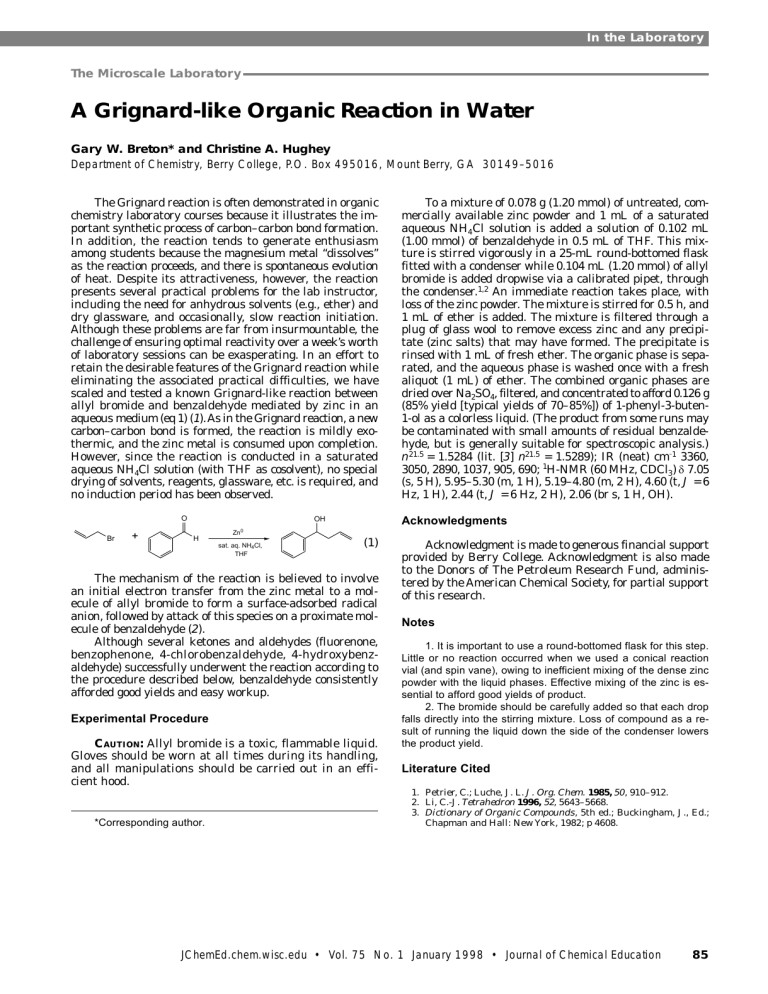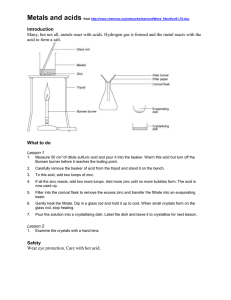
In the Laboratory
The Microscale Laboratory
A Grignard-like Organic Reaction in Water
Gary W. Breton* and Christine A. Hughey
Department of Chemistry, Berry College, P.O. Box 495016, Mount Berry, GA 30149–5016
The Grignard reaction is often demonstrated in organic
chemistry laboratory courses because it illustrates the important synthetic process of carbon–carbon bond formation.
In addition, the reaction tends to generate enthusiasm
among students because the magnesium metal “dissolves”
as the reaction proceeds, and there is spontaneous evolution
of heat. Despite its attractiveness, however, the reaction
presents several practical problems for the lab instructor,
including the need for anhydrous solvents (e.g., ether) and
dry glassware, and occasionally, slow reaction initiation.
Although these problems are far from insurmountable, the
challenge of ensuring optimal reactivity over a week’s worth
of laboratory sessions can be exasperating. In an effort to
retain the desirable features of the Grignard reaction while
eliminating the associated practical difficulties, we have
scaled and tested a known Grignard-like reaction between
allyl bromide and benzaldehyde mediated by zinc in an
aqueous medium (eq 1) (1). As in the Grignard reaction, a new
carbon–carbon bond is formed, the reaction is mildly exothermic, and the zinc metal is consumed upon completion.
However, since the reaction is conducted in a saturated
aqueous NH4Cl solution (with THF as cosolvent), no special
drying of solvents, reagents, glassware, etc. is required, and
no induction period has been observed.
O
Br
+
OH
H
Acknowledgments
Zn0
sat. aq. NH4Cl,
THF
(1)
The mechanism of the reaction is believed to involve
an initial electron transfer from the zinc metal to a molecule of allyl bromide to form a surface-adsorbed radical
anion, followed by attack of this species on a proximate molecule of benzaldehyde (2).
Although several ketones and aldehydes (fluorenone,
benzophenone, 4-chlorobenzaldehyde, 4-hydroxybenzaldehyde) successfully underwent the reaction according to
the procedure described below, benzaldehyde consistently
afforded good yields and easy workup.
Experimental Procedure
C AUTION: Allyl bromide is a toxic, flammable liquid.
Gloves should be worn at all times during its handling,
and all manipulations should be carried out in an efficient hood.
*Corresponding author.
To a mixture of 0.078 g (1.20 mmol) of untreated, commercially available zinc powder and 1 mL of a saturated
aqueous NH4 Cl solution is added a solution of 0.102 mL
(1.00 mmol) of benzaldehyde in 0.5 mL of THF. This mixture is stirred vigorously in a 25-mL round-bottomed flask
fitted with a condenser while 0.104 mL (1.20 mmol) of allyl
bromide is added dropwise via a calibrated pipet, through
the condenser.1,2 An immediate reaction takes place, with
loss of the zinc powder. The mixture is stirred for 0.5 h, and
1 mL of ether is added. The mixture is filtered through a
plug of glass wool to remove excess zinc and any precipitate (zinc salts) that may have formed. The precipitate is
rinsed with 1 mL of fresh ether. The organic phase is separated, and the aqueous phase is washed once with a fresh
aliquot (1 mL) of ether. The combined organic phases are
dried over Na2SO4, filtered, and concentrated to afford 0.126 g
(85% yield [typical yields of 70–85%]) of 1-phenyl-3-buten1-ol as a colorless liquid. (The product from some runs may
be contaminated with small amounts of residual benzaldehyde, but is generally suitable for spectroscopic analysis.)
n 21.5 = 1.5284 (lit. [3] n21.5 = 1.5289); IR (neat) cm {1 3360,
3050, 2890, 1037, 905, 690; 1H-NMR (60 MHz, CDCl3 ) δ 7.05
(s, 5 H), 5.95–5.30 (m, 1 H), 5.19–4.80 (m, 2 H), 4.60 (t, J = 6
Hz, 1 H), 2.44 (t, J = 6 Hz, 2 H), 2.06 (br s, 1 H, OH).
Acknowledgment is made to generous financial support
provided by Berry College. Acknowledgment is also made
to the Donors of The Petroleum Research Fund, administered by the American Chemical Society, for partial support
of this research.
Notes
1. It is important to use a round-bottomed flask for this step.
Little or no reaction occurred when we used a conical reaction
vial (and spin vane), owing to inefficient mixing of the dense zinc
powder with the liquid phases. Effective mixing of the zinc is essential to afford good yields of product.
2. The bromide should be carefully added so that each drop
falls directly into the stirring mixture. Loss of compound as a result of running the liquid down the side of the condenser lowers
the product yield.
Literature Cited
1. Petrier, C.; Luche, J. L. J. Org. Chem. 1985, 50, 910–912.
2. Li, C.-J. Tetrahedron 1996, 52, 5643–5668.
3. Dictionary of Organic Compounds, 5th ed.; Buckingham, J., Ed.;
Chapman and Hall: New York, 1982; p 4608.
JChemEd.chem.wisc.edu • Vol. 75 No. 1 January 1998 • Journal of Chemical Education
85



